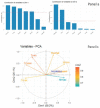Evolution of Malaria Incidence in Five Health Districts, in the Context of the Scaling Up of Seasonal Malaria Chemoprevention, 2016 to 2018, in Mali
- PMID: 33478166
- PMCID: PMC7844620
- DOI: 10.3390/ijerph18020840
Evolution of Malaria Incidence in Five Health Districts, in the Context of the Scaling Up of Seasonal Malaria Chemoprevention, 2016 to 2018, in Mali
Abstract
Context: In Mali, malaria transmission is seasonal, exposing children to high morbidity and mortality. A preventative strategy called Seasonal Malaria Chemoprevention (SMC) is being implemented, consisting of the distribution of drugs at monthly intervals for up to 4 months to children between 3 and 59 months of age during the period of the year when malaria is most prevalent. This study aimed to analyze the evolution of the incidence of malaria in the general population of the health districts of Kati, Kadiolo, Sikasso, Yorosso, and Tominian in the context of SMC implementation.
Methods: This is a transversal study analyzing the routine malaria data and meteorological data of Nasa Giovanni from 2016 to 2018. General Additive Model (GAM) analysis was performed to investigate the relationship between malaria incidence and meteorological factors.
Results: From 2016 to 2018, the evolution of the overall incidence in all the study districts was positively associated with the relative humidity, rainfall, and minimum temperature components. The average monthly incidence and the relative humidity varied according to the health district, and the average temperature and rainfall were similar. A decrease in incidence was observed in children under five years old in 2017 and 2018 compared to 2016.
Conclusion: A decrease in the incidence of malaria was observed after the SMC rounds. SMC should be applied at optimal periods.
Keywords: Mali; Seasonal Malaria Chemoprevention; incidence; malaria.
Conflict of interest statement
The authors declare no conflict of interest.
Figures
Similar articles
-
Measuring the impact of seasonal malaria chemoprevention as part of routine malaria control in Kita, Mali.Malar J. 2017 Aug 10;16(1):325. doi: 10.1186/s12936-017-1974-x. Malar J. 2017. PMID: 28797263 Free PMC article.
-
Impact of seasonal malaria chemoprevention on hospital admissions and mortality in children under 5 years of age in Ouelessebougou, Mali.Malar J. 2020 Mar 3;19(1):103. doi: 10.1186/s12936-020-03175-y. Malar J. 2020. PMID: 32126989 Free PMC article. Clinical Trial.
-
Evaluation of seasonal malaria chemoprevention in two areas of intense seasonal malaria transmission: Secondary analysis of a household-randomised, placebo-controlled trial in Houndé District, Burkina Faso and Bougouni District, Mali.PLoS Med. 2020 Aug 21;17(8):e1003214. doi: 10.1371/journal.pmed.1003214. eCollection 2020 Aug. PLoS Med. 2020. PMID: 32822362 Free PMC article. Clinical Trial.
-
Effect of seasonal malaria chemoprevention in children between 5 and 9 years old in Kita and Bafoulabe districts, Mali.Parasite Epidemiol Control. 2022 Jun 22;18:e00258. doi: 10.1016/j.parepi.2022.e00258. eCollection 2022 Aug. Parasite Epidemiol Control. 2022. PMID: 35789762 Free PMC article. Review.
-
An exploratory study of seasonal malaria chemoprevention and pharmacovigilance for under-five children in Kebbi State, Nigeria.Indian J Public Health. 2023 Jul-Sep;67(3):352-356. doi: 10.4103/ijph.ijph_577_23. Indian J Public Health. 2023. PMID: 37929374 Review.
Cited by
-
Population impact of malaria control interventions in the health district of Kati, Mali.PLoS One. 2024 Dec 31;19(12):e0289451. doi: 10.1371/journal.pone.0289451. eCollection 2024. PLoS One. 2024. PMID: 39739743 Free PMC article.
-
Malaria-associated risk factors among adolescents living in areas with persistent transmission in Senegal: a case-control study.Malar J. 2022 Jun 20;21(1):193. doi: 10.1186/s12936-022-04212-8. Malar J. 2022. PMID: 35725475 Free PMC article.
-
Asymptomatic Plasmodium falciparum infections and determinants of carriage in a seasonal malaria chemoprevention setting in Northern Cameroon and south Senegal (Kedougou).Malar J. 2024 Dec 18;23(1):386. doi: 10.1186/s12936-024-05150-3. Malar J. 2024. PMID: 39696387 Free PMC article.
References
-
- WHO: World Health Organization . World Malaria Report. WHO; Geneva, Switzerland: 2018. p. 210.
-
- DGSHP . Mali Annuaire Statistique Du Système Local Information Saniatire 2018 (SLIS) DGSHP; Bamako, Mali: 2018.
-
- WHO . Global Technical Strategy for Malaria 2016–2030. WHO; Geneva, Switzerland: 2015.
-
- AOOS P/MTN—Paludisme et Maladies Tropicales Négligées(MTN) Au Sahel|Organisation Ouest Africaine de La Santé. [(accessed on 29 October 2020)]; Available online: https://www.wahooas.org/web-ooas/fr/projets/pmtn-paludisme-et-maladies-t....
-
- World Health Organization . Chimioprévention du Paludisme Saisonnier par L’administration de la Sulfadoxine Pyrimethamine et L’amodiaqune: Guide de Terrain. WHO; Geneva, Switzerland: 2013.
Publication types
MeSH terms
Substances
LinkOut - more resources
Full Text Sources
Other Literature Sources
Medical




